Birds come in all shapes, colors, and sizes – out of the 18,000 species that exist today there are plenty of those that are small and green! Their miniature size and green color allow them to blend well with the environment and stay out of sight of larger raptors.
Although the green color is mostly associated with parrots, it can be found in a wide variety of species, from hummingbirds to swallows.
You might be surprised to learn that only turacos, birds found in Africa, are truly green due to a unique pigment called turacoverdin. All the others get their green color as a result of the light refraction or bending.
Table of Contents
21 Small Green Birds
Examples of small green birds include the green honeycreeper, Pacific parrotlet, green kingfisher, ovenbird, Asian green bee-eater, green-crowned woodnymph, and many others.
1. Asian Green Bee-eater
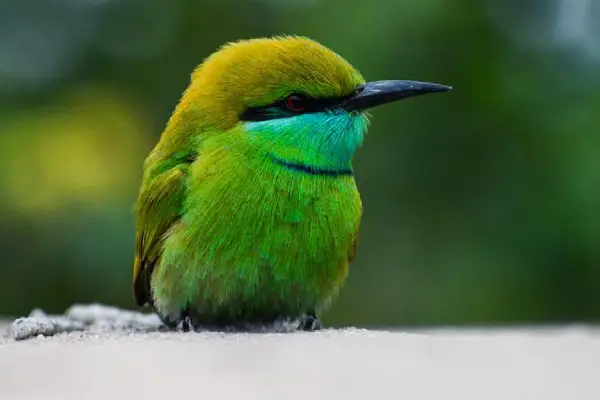
- Scientific Name: Merops orientalis
- Length: 9 in
- Wingspan: 11.6 in
- Weight: 0.53-0.7 oz
Also known as little green bee-eaters, the Asian green bee-eaters are small and slender birds commonly found in Asia and Africa.
They are mostly green with blue parts on the chins and throats, slender black face masks, and black throat bands. Their eyes are crimson red, their beaks are black, and their legs are dark gray.
They can be identified by their nasal trill “tree-tree” calls that they usually give in flight.
Asian green bee-eaters are common around open woodlands, fields, farmlands, and human habitats. They can be often seen flying gracefully and catching insects and other prey.
Asian green bee-eaters got named after their favorite type of food – bees. They can be often seen in small groups and in large numbers when roosting, often exceeding 200 birds.
Want to see examples of charming green and yellow birds? Check this article.
2. Pacific Parrotlet

- Scientific Name: Forpus coelestis
- Length: 4.3–5.5 in
- Wingspan: 9.5 in
- Weight: 1 oz
Pacific parrotlets are small green parrots found in tropical forests of Central and South America.
Males are green and have a blue patch behind the eyes and blue parts of the wings and the rumps. Females do not have blue parts of the wings but can have blue eye streaks and blue rumps.
Pacific parrotlets also have pinkish beaks and pinkish-gray legs and feet. They are social birds that can gather in flocks of over 100 birds, spending hours each day in the trees where they forage for fruit and seeds.
Pacific parrotlets are popular pets that are nicknamed “pocket parrots” due to their small size. They can learn to speak a few words and phrases, similar to other parrots; however, their vocabulary is relatively limited.
They are colorful, charming, and intelligent, but can become very aggressive in captivity and attack other birds when confined. Pacific parrotlets are omnivores that feed on berries and cactus fruits in the wild; in captivity, they also consume seeds, fruit, vegetables, and herbs.
3. Ruby-throated Hummingbird
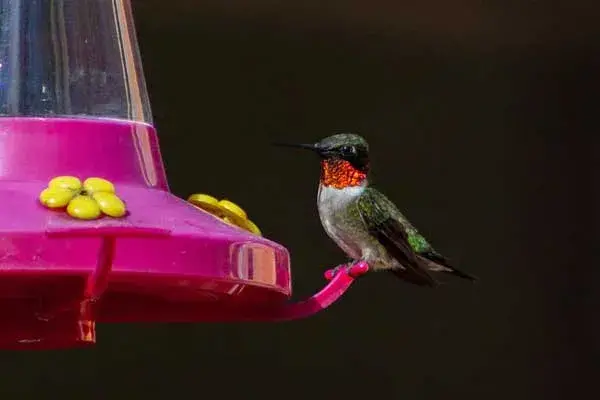
- Scientific Name: Archilochus colubris
- Length: 2.8-3.6 in
- Wingspan: 3.1-4.3 in
- Weight: 0.07-0.2 oz
Ruby-throated hummingbirds are one of the smallest birds in North America.
They can have a wingspan of as little as 3.1 inches and weigh less than a penny (0.07 oz)!
Males have metallic emerald green upperparts, grayish-white underparts, black wings, and a gorget (throat patch) of iridescent ruby red. Their tails are forked. Females are larger than males, have slightly shorter beaks, and have white throats.
Ruby-throated hummingbirds are one of the most common hummingbirds found east of the Mississippi River in the USA. During winter, these tiny green birds can also be seen in southern Florida.
Ruby-throated hummingbirds move very quickly, around 25 mph, and will beat their wing over 50 times per second. They only have about 940 feathers on average which is the smallest number of any bird.
These birds are mostly solitary, except during the breeding season which lasts a few days.
To attract these hummingbirds with red necks to your backyard, you can set up hummingbird feeders or plant tubular flowers. They are quite bold and might even feed at hanging plants and feeders on your porch or next to your windows!
Read More: Examples of smallest birds seen in Michigan
4. Buff-bellied Hummingbird
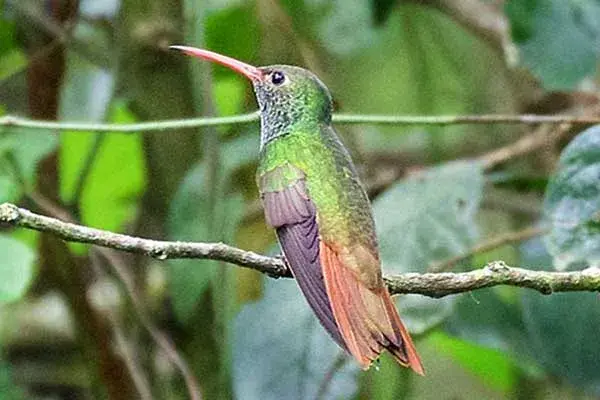
- Scientific Name: Amazilia yucatanensis
- Length: 3.9-4.3 in
- Wingspan: 5.75 in
- Weight: 0.1-0.17 oz
Buff-bellied hummingbirds are rare vagrant visitors along the Gulf Coast that can be seen during fall and winter in the Florida panhandle (West Florida).
These medium-sized birds are easy to identify by their metallic olive green colors, red bills, orange and slightly forked tails, and buffy patches on their bellies. They also have metallic golden-green throats.
Look for them around hummingbird feeders, where they use their size advantage to chase off smaller hummingbirds. Their diet includes mostly nectar and insects.
Buff-bellied hummingbirds are partially migratory and prefer pine-oak forests, semi-arid scrub, and thickets along watercourses.
Females will build their nests in shrubs and trees to protect the eggs and both males and females will ferociously defend feeding locations within their territories. Females lay two white eggs.
5. Green Honeycreeper

- Scientific Name: Chlorophanes spiza
- Length: 5.1–5.5 in
- Wingspan: n/a
- Weight: 0.49-0.81 oz
These wonderful small birds with bright colors are found in Central and South America. Green honeycreepers measure just 5.1-5.5 inches long and weigh as little as 0.49 oz.
Males and females look different: females are apple green overall with dark green flight feathers and tails, and pale green upperparts. Males are bright emerald to blue-green overall.
These tanagers live in humid evergreen forest edges, plantations, and gardens, often in pairs. Green honeycreepers are omnivores and feed fruit and insects, hopping from twig to twig in pursuit of food. Highly energetic and active, they can be very aggressive toward other birds around feeders.
6. Ruby-crowned Kinglet

- Scientific Name: Regulus calendula
- Length: 3.5-4.3 in
- Wingspan: 6.3-7.1 in
- Weight: 0.2-0.4 oz
Ruby-crowned kinglets are miniature green birds that measure 3.9 in on average in length and weigh just 0.3 oz.
They are one of the smallest North American songbirds and can be identified by their olive-green colors, two white wing bars, and white eye-rings. Males also have red crown patches, which are usually concealed.
Ruby-crowned kinglets can be found throughout North America, darting low in woods and thickets during winter.
Despite their miniature size, they make very loud and complex sounds. Ruby-crowned kinglets’ song lasts around 5 seconds and has three parts: high-pitched “zee-zee” notes, low “turr” trills, and repeated “tee-da-leet” phrases. Their call is a harsh, fast, two-parted scold.
Ruby-crowned kinglets build cup-shaped nests and have the largest clutch of any North American passerine for their size. A female may lay up to 12 eggs and that entire clutch can weigh as much as the female herself.
These birds are omnivores that mainly feed on insects, some fruits, and seeds.
7. Green Kingfisher
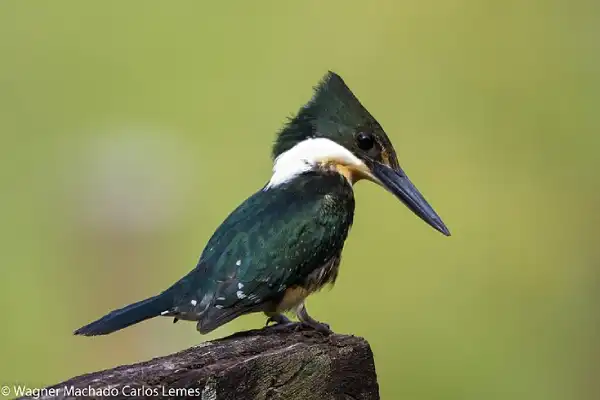
- Scientific Name: Chloroceryle americana
- Length: 7.9 in
- Wingspan: 12 in
- Weight: 1-1.9 oz
Common in North, Central, and South America, green kingfishers are always found near water.
They have dark glossy green plumage, white throats, collars, and spots on their wings. They often keep their tails cocked up and use their long beaks to fish and make their nests on the ground.
Green kingfishers are widespread and are most common in South America (down to Patagonia) and some parts of the USA, in southern Arizona and Texas. Scientists estimate that their global range spans over 6 million square miles.
Green kingfishers have two forward-facing, partially fused toes. They will use this toe arrangement called “syndactyl” as a shovel to push the soil out as they build their nest burrows.
Green kingfishers are carnivores that feed on fish, mostly on minnows and other small fish, and occasionally some insects. A group of green kingfishers is called a “clique” or a “concentration”.
8. Green-throated Carib

- Scientific Name: Eulampis holosericeus
- Length: 4.1-4.7 in
- Wingspan: n/a
- Weight: 0.19-0.27 oz
Green-throated caribs are hummingbird species found in Puerto Rico and in the Caribbeans.
First described by Swedish naturalist Carl Linnaeus in the 18th century, these miniature birds measure just 4.1-4.7 inches long.
Both sexes are mostly green with dark bellies; males also have bright green gorgets (throats).
Green-throated caribs will often make sharp “chup” calls or rattles and whirs with their wings. They live in rainforests, semi-deciduous woodlands, open secondary vegetation, agricultural areas, and parks where they feed on insects caught in flight. Green-throated caribs are omnivores and will also consume spiders and flower nectar.
Males are territorial and will give warning calls to intruders before attacking them in flight. Males will mate with several females while females will do all the parental work, from nest building to raising young.
9. Ovenbird
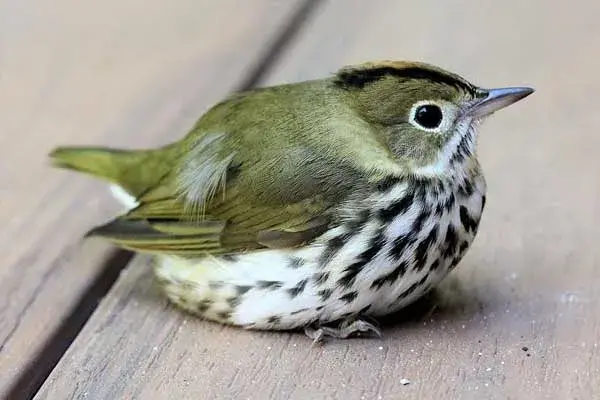
- Scientific Name: Seiurus aurocapilla
- Length: 4.3-6.3 in
- Wingspan: 7.5-10.2 in
- Weight: 0.49-1.02 oz
These small migratory songbirds can be identified by their olive-green upperparts, black and white underparts, white rings around the eyes, and the black stripe below the cheeks. They also have dark eyes, a dark upper part of a thin pointed beak, a horn-colored lower part, and pinkish legs and feet.
Ovenbirds spend summer in eastern parts of North America before moving to winter in Central America, Florida, several Caribbean islands, and northern Venezuela.
Look for them often skulking in the forest understory and listen for their territorial rapid, resounding “tea-cher, tea-cher” song consisting of 8-13 phrases. Ovenbirds also have several short calls, including the “ple-bleep,” “whink,” and high “tsip.”
They can be also recognized by walking instead of hopping. Ovenbirds got their name from the nest they build called the “oven” – it is a dome-like structure placed on the ground with a side entrance that makes it resemble a Dutch oven.
When a predator is nearby the nest, the female can perform a distraction display and simulate a crippled bird.
10. Violet-green Swallow
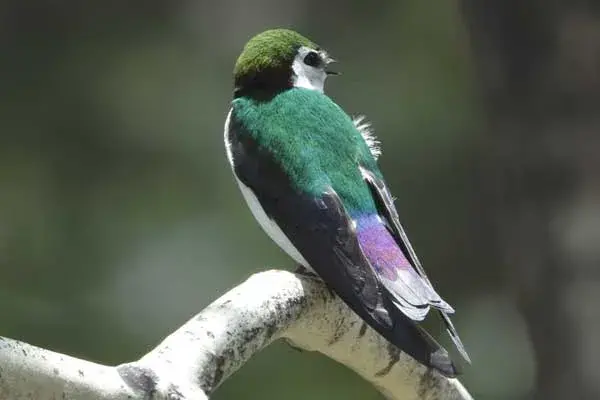
- Scientific Name: Tachycineta thalassina
- Length: 4.7 in
- Wingspan: 10.6 in
- Weight: 0.5 oz
With a wingspan of 10.6 inches and a length of 4.7 in, violet-green swallows are among the smallest swallows in North America.
They can be identified by long pointed wings, slightly forked tails, white faces in adult males, turquoise metallic green upperparts, and purple rumps in good light.
Violet-green swallows live in a number of habitats including deciduous and coniferous forests; they move to Mexico and Central America for winter.
When interacting with other swallows, violet-green swallows will emit “chee-chee” calls; during courtship displays, they will make “twitter” calls.
These small green-headed North American birds will perform acrobatic stunts over lakes and streams high in the sky, in search of flying insects. Their diet consists of ants, beetles, flies, and spiders.
Violet-green swallows are secondary cavity nesters – they take advantage of abandoned cavities of other birds. They are social and can be found in large groups of 10 to 100, together with other swifts and swallows.
The recorded top speed of violet-green sparrows is 28 mph – as a comparison, the fastest bird of prey, the peregrine falcon, has an average speed of 25–35 mph.
11. Swainson’s Warbler
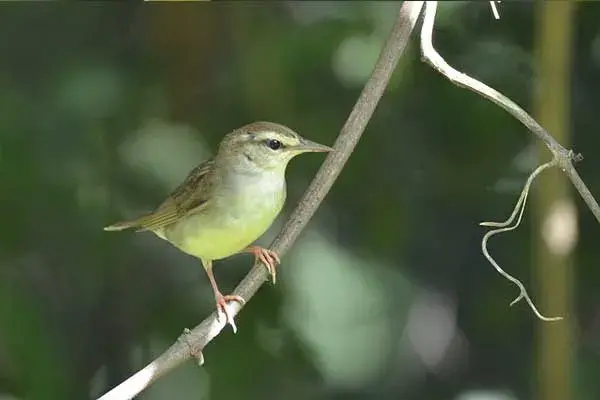
- Scientific Name: Limnothlypis swainsonii
- Length: 4.9–6.3 in
- Wingspan: 9.1 in
- Weight: 0.39–0.72 oz
Named after an English ornithologist William Swainson, these small and green New World warblers are found in eastern parts of the United States.
Swainson’s warblers are solidly built songbirds with flat heads, heavy beaks, and strong legs. Sexes are similar and are greenish-brown above and pale yellow-white below.
You will find them around moist woods and marshes. Swainson’s warblers are loud when their breeding season starts (March-April); they sing less frequently the rest of the year.
Males have a loud cascading “teer teer teer” song that is similar to the one of Louisiana waterthrush. Males and females will also emit sharp, resonant “chip” calls. These birds are mostly monogamous and pairs will together defend a nesting territory.
12. Painted Bunting

- Scientific Name: Passerina ciris
- Length: 4.7–5.5 in
- Wingspan: 8.3–9.1 in
- Weight: 0.46–0.67 oz
Sometimes called “nonpareil”, meaning “unrivaled”, painted buntings are one of the most colorful of all US-breeding birds, at least the males are.
Female painted buntings usually have bright yellow-green plumage, while males are a mix of blue, red, and green.
Painted buntings are common around woods, fields, or feeders, but you might have trouble finding them there since they like to stay hidden in deep brush. The best time to see and hear them would be early in the morning when the males usually sing.
Florida is the only US state with both a breeding and a wintering population of these green birds.
They might look cute and colorful, but painted buntings are aggressive. They can be very territorial and attack other males of their species.
Painted buntings are omnivores that mostly feed on seeds and insects. A group of painted buntings is known as a “mural” and a “palette”.
13. Javan Green Magpie
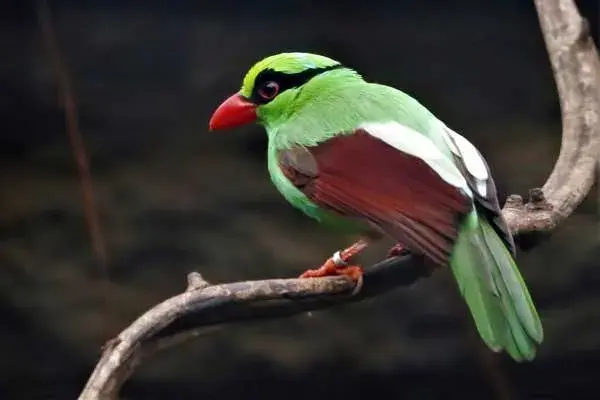
- Scientific Name: Cissa thalassina
- Length: 9.6-11.8 in
- Wingspan: n/a
- Weight: 4.4 oz
These brightly colored songbirds are one of Indonesia’s most beautiful green birds. They are also the most endangered, with a population of less than 50 mature individuals in existence today.
Javan green magpies, as the name suggests, are native to montane forests on the Indonesian island of Java. Although born blue, these birds will turn apple green after their first molting due to a pigment in their diet called lutein.
Studies have shown that the vibrant, green feathers of the Javan magpie are important for attracting a mate for successful breeding. Also, during the mating display, they will raise their black masks. They are carnivores that feed on insects, small lizards, and frogs.
Due to habitat loss and illegal capture, they are now listed as Critically Endangered by the International Union for Conservation of Nature (IUCN).
14. Green-crowned Woodnymph
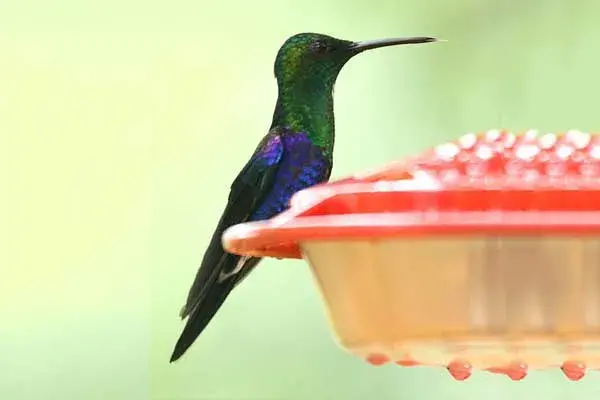
- Scientific Name: Thalurania fannyi
- Length: 3.7-4.5 in
- Wingspan: n/a
- Weight: 0.14-0.19 oz
These South American hummingbirds can be found in evergreen forests and the edges of tropical lowlands, often near streams.
Male green-crowned woodnymphs are green above with iridescent green heads, throats, and breasts. Their underparts are deep iridescent blue and the tails are dark blue and deeply forked
These birds found in Belize and Guatemala to northern Peru, mostly feed on nectar taken from a variety of brightly colored, scented small flowers of trees, herbs, shrubs, and epiphytes.
Green-crowned woodnymphs are polygynous and a male may mate with several females; the female will do the same with several males. Males will not participate in choosing the nest location, building it, or raising the chicks.
15. Little Green Sunbird
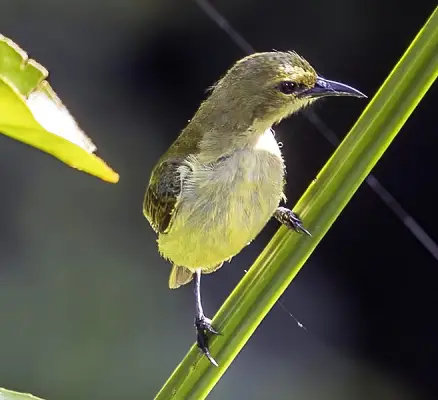
- Scientific Name: Anthreptes seimundi
- Length: 3.7 in
- Wingspan: n/a
- Weight: 0.17-0.38 oz
Little green sunbirds, also known as Seimund’s sunbirds, are very small, green sunbirds found in Africa. They have slightly curved pinkish beaks and pale eye rings.
Little green sunbirds inhabit the canopy and mid-story of humid forests where they feed mostly on nectar, fig seeds, and some insects. They will also emit high-pitched “tseet” calls.
16. Budgerigar
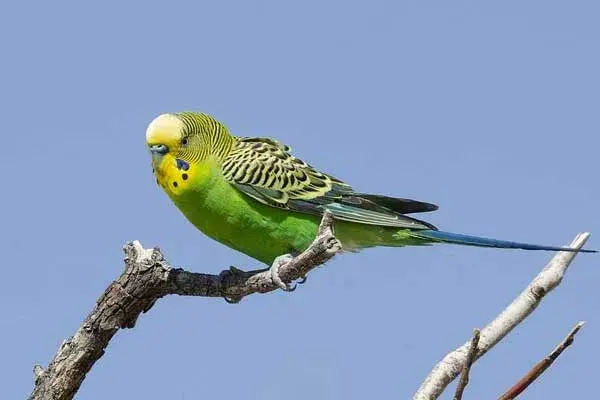
- Scientific Name: Melopsittacus undulatus
- Length: 7 in
- Wingspan: 12 in
- Weight: 1.1–1.4 oz
Budgerigars, also called common parakeets, are small seed-eating parrots with long tails.
They are nicknamed budgies and are the third most popular pets in the world, right behind dogs and cats.
Budgies come in many shapes and colors; wild budgies have green-yellow plumage, with black, scalloped markings on the nape, back, and wings.
They inhabit drier parts of Australia and also have a large population near St. Petersburg, west-central Florida. The consistent climate conditions in Florida significantly reduced their nomadic behavior so they are now year-round residents in the state.
These birds have a third eyelid, just like camels or llamas. They are very intelligent and can count up to three and even learn a few words.
When the breeding season comes, female budgies can gain significant weight, up to 20% more than their usual weight. This is because they retain calcium during that period.
17. Anna’s Hummingbird
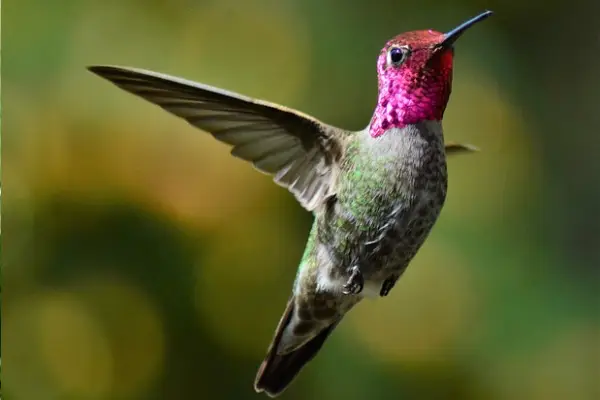
- Scientific Name: Calypte anna
- Length: 3.9-4.3 in
- Wingspan: 4.7 in
- Weight: 0.1-0.2 oz
These small green birds are named after Anna Masséna, the Duchess of Rivoli. Anna’s hummingbirds are tiny hummingbirds with straight, shortish beaks, and fairly broad and forked tails in males.
You will identify them by their iridescent bronze-green backs, pale grey chests and bellies, and green flanks. Males have iridescent reddish-pink heads and gorgets that extend to the sides of the neck and throat. Females are grayish and have green heads with a small amount of red on their throats.
Using their long tongues, Anna’s hummingbirds feed on flower nectar. They also eat some small insects they catch mid-flight.
In the early 20th century, Anna’s hummingbirds only breed in northern Baja California and southern California. They have expanded their breeding range since.
Scientists estimate that Anna’s hummingbirds have a population of around 1.5 million individuals.
Together with other birds, Anna’s hummingbirds are common in southern and northern parts of California and western parts of Washington.
18. Cuban Emerald
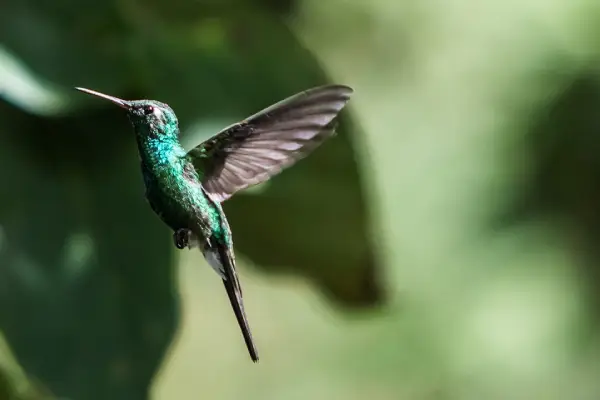
- Scientific Name: Riccordia ricordii
- Length: 3.7-4.5 in
- Wingspan: n/a
- Weight: 0.08-0.18 oz
Cuban emeralds are small green hummingbirds found in Cuba and the Bahamas.
Females are smaller than males and measure just 3.7-4.1 inches long. Males are iridescent green with red beak bases while the females are metallic green above and whitish below; both sexes have long and forked tails.
These hummingbirds are common in different wooded habitats, feeding on flowers and insects. They might visit Florida, but that happens very rarely. They can be very vocal and make long series of high-pitched squeaks, buzzes, and “tsee-tsee” calls.
19. Red-Throated Barbet

- Scientific Name: Psilopogon mystacophanos
- Length: 8.9–9.5 in
- Wingspan: n/a
- Weight: 2.1–3.4 oz
These small birds are found in forests and swamps of Asia, in Thailand, Singapore, Myanmar, Malaysia, Indonesia, and Brunei.
Red-throated barbets are mostly green with several other colors on their heads. Males have yellow, black, blue, and red facial patches, while females only have red and blue.
Due to their green color and smaller size, they are hard to notice in the canopy; they are best identified by their song consisting of a series of hoots.
20. Rainbow Lorikeet
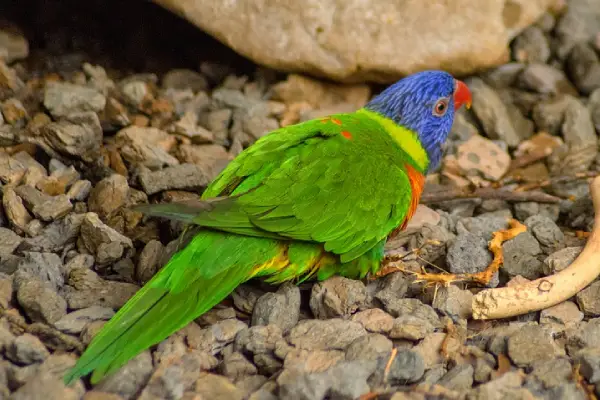
- Scientific Name: Trichoglossus moluccanus
- Length: 9.8 to 11.8 in
- Wingspan: 18 in
- Weight: 2.6–5.5 oz
These small brightly colored parrots are found in Australia.
Rainbow lorikeets have deep blue heads and bellies, green upperparts (wings, backs, and tails), thighs, and rumps. Their chests are orange/yellow.
Adult lorikeets have orange beaks while juvenile birds hatch with black ones. These green parrots can be seen in woodlands, rainforests, and urban areas with many trees.
They are friendly and intelligent birds with an estimated population of over 5 million. Rainbow lorikeets are omnivores that mostly eat nectar, pollens, fruits, berries, blossoms, and buds. They might eat insects occasionally.
They make excellent pets and are very affectionate, playful, and constantly active. Rainbow lorikeets got accidentally released in the 1960s in Australia and are now considered pests, out-competing many native birds for food.
Read More: 25 stunning orange-blue birds of the world
21. Malachite Sunbird
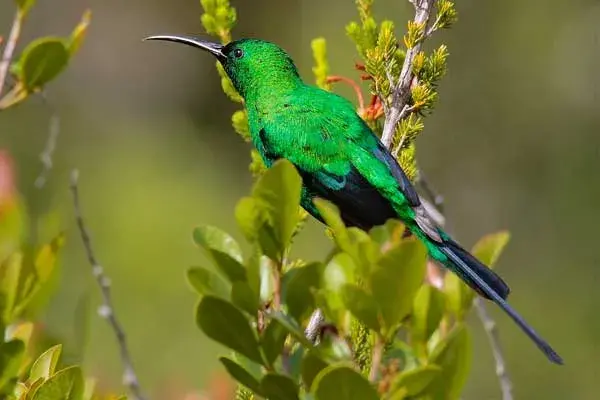
- Scientific name: Nectarinia famosa
- Length: 5.1-10.6 in
- Wingspan: n/a
- Weight: 0.42-0.79 oz
Malachite sunbirds are small nectarivorous birds with metallic green heads and black-green wings with small yellow pectoral patches.
When breeding, malachites can be found in pairs; otherwise, they are usually solitary. Males are aggressive to birds of the same species and other sunbirds.
Like most sunbirds, malachite sunbirds are omnivores that mainly feed on nectar. They might also eat insects, especially when feeding young. Because of their mostly nectar-based diets, these birds are responsible for pollinating many flowering plants.
They can be spotted in fynbos, moorland, grassland, scrub, and exotic tree plantations.
Read More: Examples of miniature snow-white birds and Examples of miniature coal-black birds